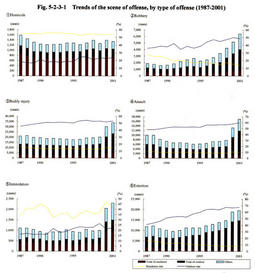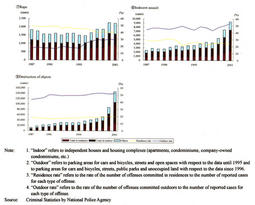| Previous Next Index Image Index Year Selection | |
|
|
1 Trends of the scene of the offense Fig. 5-2-3-1 shows the trends of the scene of offense in respect of homicide and the 9 types of violent offenses except for breaking and entering. The outdoor rate in the figures refers to the rate of offenses committed in parking areas for cars and bicycles, on streets, or in open spaces (including parks and unoccupied land). The residence rate refers to the rate of offenses committed in residences. Residences include independent houses and housing complexes (e.g. apartments, condominiums, company-owned condominiums, etc.).
According to the overall trends of the scene of offense in respect of homicide and the 9 types of violent offenses except for breaking and entering, the outdoor rate showed an obvious upward trend whereas the residence rate generally showed a flat or long-term downward trend. Fig. 5-2-3-1 Trends of the scene of offense, by type of offense (1987-2001) As for homicide, the residence rate remained flat while the outdoor rate increased only slightly on a long-term basis, without any significant fluctuations. With such trends taken into consideration together with the acquaintance rate mentioned in the previous section, it is recognized that most homicide cases were committed against acquaintances of the perpetrators in residences.As for robbery, the outdoor rate shifted from the previous flat trend to an upward trend in around 1995 and it reached 50% in 2000, which was particularly due to a significant increase of on-the-street robbery cases. On the other hand, the residence rate has been more or less constantly decreasing since 1988 and it fell to 14% in 2001. However, the number of reported cases of robbery committed in residences was on the rise, in particular, the number of robberies involving intrusion and the number of burglary increased rapidly. The decline of the residence rate seems to be due to the fact that the number of on-the-street robbery and robbery committed in buildings other than residences increased more than the increase in the total number of reported cases of robbery (See Section 4 of this Chapter ). As for extortion, though almost the same trends as those of robbery were indicated, the outdoor rate nearly reached 70% in 2001, which indicates that extortion is more likely to be committed outdoors than robbery. As for bodily injury and assault, almost identical trends were indicated, with the outdoor rate for bodily injury surpassing the 50% mark and the rate for bodily injury nearly reaching 60%. The numbers of reported cases of bodily injury and assault committed in residences increased in 2000 and 2001. As for intimidation, the residence rate was high and the outdoor rate was just a half of it. As for rape and indecent assault, the outdoor rate has been increasing in recent years, and in 2001, the rate nearly reached 30% in respect of rape and exceeded 50% in respect of indecent assault. The number of reported cases of indecent assault committed on trains (excluding Shinkansen bullet trains) and buses has been on the rise: 160 cases in 1991, 312 cases in 1996, and 550 cases in 2001. As for destruction of objects, the outdoor rate has been within a range between 49% and 53% since 1990 and the residence rate has been about 20% since 1987. About 70% of the reported cases of destruction of objects was committed outdoors or in residences and the rest was committed in restaurants, department stores/supermarkets, and schools. |

